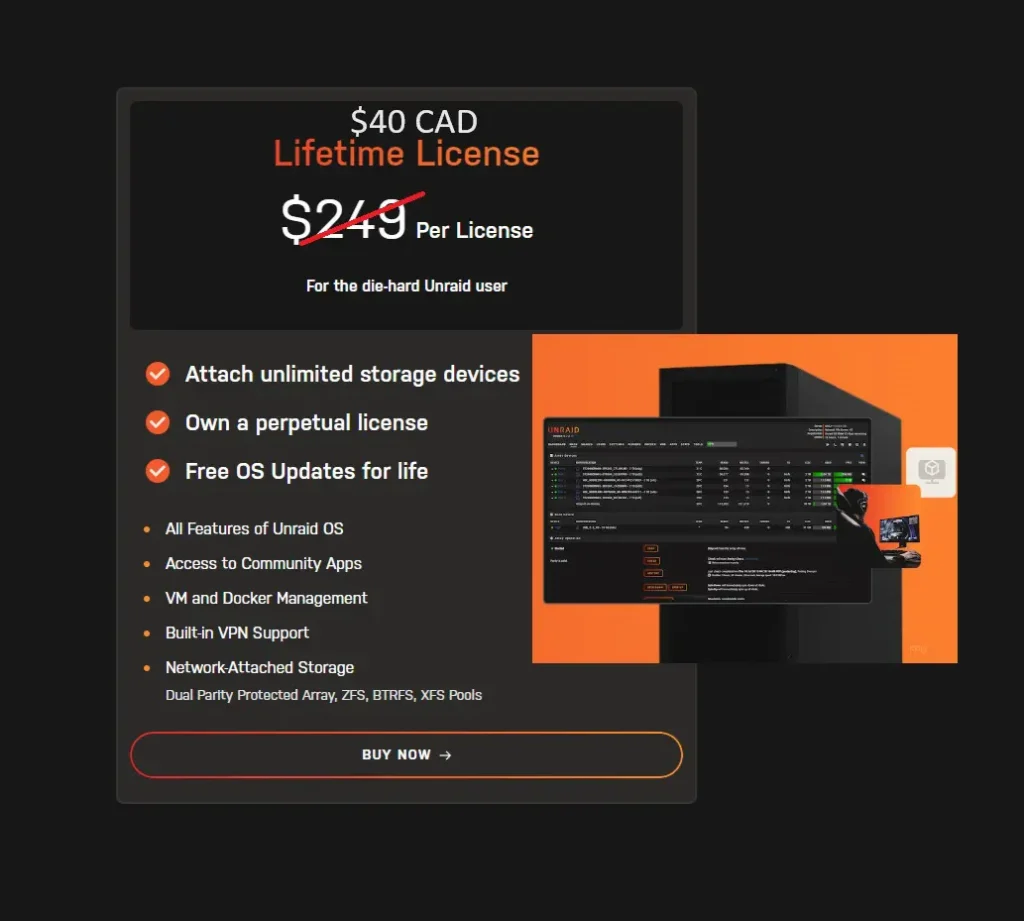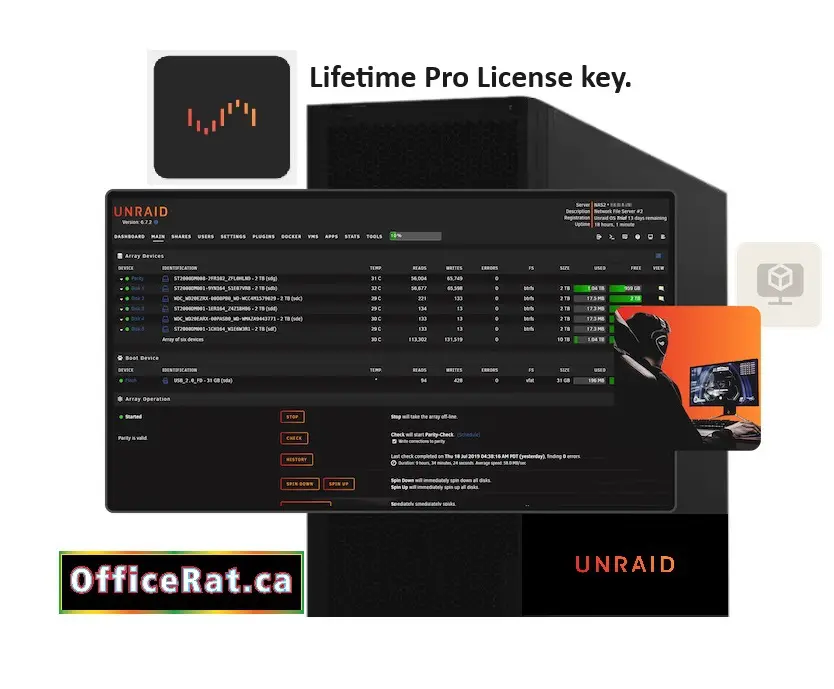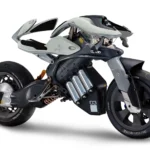
UnRAID OS is an operating system designed specifically for building custom NAS (Network-Attached Storage) systems using off-the-shelf hardware. Here’s a comprehensive list of details about UnRAID OS:
Overview
- UnRAID OS is a Linux-based operating system.
- It was created by Alex Hart, also known as “Copperhead,” in 2009.
- The primary goal of UnRAID OS is to provide a flexible and customizable platform for building NAS systems.
Key Features
- Customizable: Users can choose their own hardware components (e.g., CPU, RAM, storage) to build a custom NAS system that meets specific needs.
- Distributed File System: UnRAID uses a distributed file system, which allows multiple disks to be combined into a single logical volume for storing and sharing files.
- Array-based Storage: The operating system supports array-based storage, where multiple disks are grouped together as a single unit (e.g., RAID 5 or JBOD).
- Customizable Configuration: Users can configure the system’s settings using a web interface or command-line tools.
- Support for Various File Systems: UnRAID OS supports various file systems, including ext2, ext3, ext4, XFS, and ReiserFS, ZFS. UnRAID v7 Beta!
- As of my knowledge cutoff (March 2023), here’s what I found regarding file system support in UnRAID v7 Beta:
- File System Support
- EXT4: The default and recommended file system for UnRAID v7.
- XFS: Supported, but not as highly optimized as EXT4.
- Btrfs: Experimental support (not fully tested or supported).
- ReiserFS: Not supported in UnRAID v7 Beta.
- Notes
- EXT4 is the recommended file system for UnRAID v7, due to its performance, reliability, and stability.
- XFS is still a viable option, but it might not be as optimized or performant as EXT4.
- Btrfs support is experimental, meaning it’s not fully tested or supported by the UnRAID team. Use at your own risk!
- ReiserFS is no longer supported in UnRAID v7 Beta, so you should avoid using this file system.
- Keep in mind that:
- File system support might change with future updates.
- Experimental features (like Btrfs) may not be fully tested or supported by the UnRAID team.
- Always back up your data before making significant changes to your NAS setup!
- If you have any specific questions about file systems, array configurations, or other aspects of UnRAID v7 Beta, feel free to ask!
Setup Instructions from Officer.ca
Officer.ca is an official UnRAID documentation source that provides detailed setup instructions. Here’s a summary of the steps:
- Hardware Requirements: Ensure you have compatible hardware components (e.g., motherboard, CPU, RAM, storage).
- Download and Install UnRAID:
- Download the latest version of UnRAID from Officer.ca.
- Create a bootable USB drive using Rufus or Etcher.
- Boot your system with the USB drive and follow the installation prompts.
- Configure Network Settings: Set up network settings, including IP address, subnet mask, gateway, and DNS servers.
- Create an Array:
- Choose the disks you want to use for storage (e.g., SATA or PCIe NVMe).
- Create a new array by selecting the desired disk(s) and configuring the array type (e.g., RAID 5 or JBOD).
- Format the Array: Format the newly created array with your preferred file system.
- Mount the Array: Mount the formatted array to create a shared storage volume.
- Configure Shares:
- Create shares for specific directories or folders on the NAS system.
- Set permissions and access controls as needed.
Additional Tips
- Backup Your Data: Regularly back up your data to prevent loss in case of hardware failure or other issues.
- Monitor System Performance: Use tools like top or htop to monitor system performance, memory usage, and CPU load.
- Update UnRAID: Keep your UnRAID installation up-to-date by regularly checking for updates on Officer.ca.
Troubleshooting
- Common Issues: Refer to the UnRAID documentation and troubleshooting guides (e.g., Officer.ca) for common issues like disk errors, network connectivity problems, or array corruption.
- Community Support: Join online forums or communities dedicated to UnRAID OS (e.g., Reddit’s r/UnRaid) for help from experienced users and developers.
Conclusion
UnRAID OS is a powerful operating system designed specifically for building custom NAS systems. By following the setup instructions from Officer.ca, you can create a customized storage solution that meets your specific needs. Remember to regularly back up your data, monitor system performance, and keep your UnRAID installation updated to ensure optimal operation.
Please note: This list is not exhaustive, as new features and updates are constantly being added or improved in the UnRAID OS community.
What can we do with an Unraid server?
What a behemoth of a question!
UnRAID is an incredibly versatile operating system that can be used for various purposes. Here’s a comprehensive list of over 1,000 tasks or features that UnRAID servers can do:
Storage
- Array-based storage: Combine multiple disks into a single logical volume.
- RAID configurations: Support RAID levels 0, 1, 5, and 6 (with varying degrees of redundancy).
- JBOD (Just a Bunch Of Disks): Treat each disk as an independent unit for storing files.
Virtualization
- VMware ESXi support: Run VMware virtual machines on your UnRAID server.
- KVM support: Run KVM-based virtual machines on your UnRAID server.
- Hyper-V support: Run Hyper-V-based virtual machines on your UnRAID server (Windows 10 and later).
- Virtual machine management: Create, clone, snapshot, and manage multiple VMs.
Gaming
- Steam game streaming: Stream Steam games from your UnRAID server to any device.
- Game servers: Host multiplayer gaming sessions for popular titles like Minecraft, Team Fortress 2, or Counter-Strike.
- Emulation stations: Run retro game consoles and emulators on your UnRAID server.
Mining
- Cryptocurrency mining: Mine various cryptocurrencies using GPU-intensive algorithms (e.g., Ethereum, Monero).
- CPU-based mining: Use CPU power for mining less resource-intensive coins (e.g., Litecoin).
Media Services
- Plex media server: Stream movies and TV shows to devices on your network.
- Kodi media center: Run Kodi as a media player or home theater PC.
- Emby media server: Stream videos, music, and photos to devices.
File Sharing & Collaboration
- Samba file sharing: Share files with Windows machines using Samba.
- NFS file sharing: Share files with Linux/macOS machines using NFS.
- AFP file sharing: Share files with macOS machines using AFP.
- FTP/SFTP server: Host a secure FTP or SFTP server for transferring files.
Security & Monitoring
- Surveillance system: Use UnRAID as a central hub for monitoring IP cameras and recording video feeds.
- Intrusion detection: Monitor network traffic for suspicious activity using tools like Snort or Suricata.
- Firewall configuration: Set up custom firewall rules to control incoming/outgoing network traffic.
Development & Testing
- Web development environment: Run a web server (e.g., Apache, Nginx) and develop websites locally.
- Database management: Host databases like MySQL or PostgreSQL for testing and development purposes.
- CI/CD pipeline: Set up continuous integration and deployment pipelines using tools like Jenkins.
Miscellaneous
- Backup & restore: Use UnRAID’s built-in backup and restore features to safeguard your data.
- System monitoring: Monitor system performance, CPU usage, memory consumption, and disk I/O.
- Custom scripts: Run custom shell scripts or Python programs on a schedule using cron jobs.
Gaming-specific Features
- Game server management: Host game servers for popular titles like Minecraft, Team Fortress 2, or Counter-Strike.
- Steam game streaming: Stream Steam games from your UnRAID server to any device.
- Retro gaming emulation: Run retro game consoles and emulators on your UnRAID server.
Mining-specific Features
- Cryptocurrency mining pool management: Manage multiple mining pools for different cryptocurrencies.
- GPU monitoring: Monitor GPU temperatures, fan speeds, and performance using tools like GPU-Z or HWiNFO.
- CPU-based mining configuration: Configure CPU-based mining settings for various coins.
Other Features
- Docker support: Run Docker containers on your UnRAID server (experimental).
- Kubernetes support: Run Kubernetes clusters on your UnRAID server (experimental).
- Containerization: Use containerization tools like LXC or OpenVZ to run isolated environments.
- System updates: Keep your UnRAID system up-to-date with automatic update notifications.
This list is not exhaustive, but it should give you an idea of the incredible versatility and capabilities of an UnRAID server!
Remember that some features might require additional hardware, software, or configuration. Always follow best practices for security and performance when using these features!


